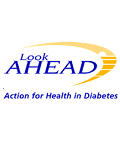Lifestyle interventions that help diabetic people lose weigh confer many health benefits—including marked reductions in depression, retinopathy, renal disease, hospitalization, healthcare costs. But they may not mitigate the cardiovascular risk associated with diabetes.
Data from the massive Look AHEAD (Action for Health in Diabetes) trial involving more than 5,000 diabetic individuals randomized to diet & lifestyle programs or no interventions and followed for a median of almost 10 years, were unequivocal: weight loss (mean 6% total body weight) translates into significantly better health, improved biomarkers, and lower cost.
 Surprisingly, there was no reduction in CV-associated mortality, non-fatal stroke, or hospitalizations for cardiovascular symptoms, prompting the study directors to stop the intended 13.5 year follow up after just 9.6 years.
Surprisingly, there was no reduction in CV-associated mortality, non-fatal stroke, or hospitalizations for cardiovascular symptoms, prompting the study directors to stop the intended 13.5 year follow up after just 9.6 years.
The absence of a meaningful impact on CVD events has puzzled researchers and clinicians alike.
Look AHEAD, overseen by the National Institute of Diabetes, Digestive and Kidney Diseases (NIDDK), involved 5,145 overweight or obese people with type 2 diabetes at 16 centers across the US.
The lifestyle intervention programs involved active counseling on calorie restriction and exercise through weekly group and individual counseling sessions during the first 6 months, with decreasing frequency over the course of the trial. Specifically, subjects were encouraged to set dietary goals of 1200 to 1800 kcal per day (with <30% of calories from fat, and >15% from protein).
They were taught to use of meal-replacement products, and to incorporate at least 175 minutes of moderate-intensity physical activity per week into their lives. Individuals in the control group participated in three group sessions per year focused on diet, exercise, and social support during years 1 through 4. In subsequent years, the frequency was reduced to one session annually.
Reduced Morbidity
There’s no doubt that the intensive intervention was effective in helping people lose weight. Mean weight loss at Year 1 was 8.6% of total body weight vs. 0.7% for the intervention and control groups, respectively. At the conclusion of the study, the numbers were 6% vs. 3.5%
Patients in the intervention group had greater decreases in glycated hemoglobin, as well as improvements on all standard cardiovascular risk factors with the exception of LDL cholesterol. The data were published in June in the New England Journal of Medicine.
“Look AHEAD showed that participants with diabetes can lose weight and maintain it,” said Rena Wing, PhD, chair of the Look AHEAD research team and professor of psychiatry & human behavior at Brown University. “This weight loss has many beneficial effects on glycemic control and CVD risk factors; however, it did not affect the risk of CVD.”
It did, however, translate into greater likelihood of partial remission of diabetes, as well as lower incidence of urinary incontinence, sleep apnea, and depression, and improvements in quality of life, physical functioning, and mobility.
In an article posted on Healio’s Endocrine Today, Look AHEAD researcher William Knowler, MD, PhD, MPH, of the diabetes epidemiology and clinical research section at the NIDDK, pointed out a significant decrease in advanced kidney disease. There were 172 cases in the control group, versus 123 in the lifestyle intervention group. Overall, there was a 31% decrease in kidney disease—and the really good news is that this cut across all demographic subgroups.
People in the intervention group also had a 14% lower incidence of retinopathy, and were 20% less likely to develop depression during the study period.
Major Cost Savings
Even without a reduction in cardiovascular events, there were major cost savings from the weight loss programs. According to University of Pennsylvania health economist Henry Glick, PhD, there was a nearly 12% reduction in hospitalizations, and a reduction in medication costs averaging $278 per patient per year, among other economic gains.
Still, the fact that there was no impact on the primary outcome measures—CV events—has clearly rankled the study’s leaders.
In their analysis, they write that they’ve considered several possibilities to explain the lack of CVD reduction: 1) lack of sufficient statistical power to detect an effect; 2) the study subjects did not achieve sufficient levels of weight loss to affect vascular function; 3) more intensive use of statins and other medications in the control group may have made the benefits of lifestyle intervention more difficult to discern.
The authors ruled out the first explanation, stating that the 95% confidence interval for the primary outcome excluded the benefit of 18% or more targeted in the trial’s design.
Regarding the second explanation (insufficient weight loss), they note that, “the differential weight loss between the two trial groups averaged 4% over the course of the study, but only 2.5% at the end. However, our trial was planned to test the effects of an intensive lifestyle intervention, and the weight loss achieved in the intervention group is representative of the best that has been achieved with current lifestyle approaches.”
The third explanation is likely the most plausible, but it is hardly a cut-and-dried matter, because the differences in medication use were fairly small. Buy the end of the study, 74% of the control group and 71% of the intervention group were on statins. For insulin, the numbers were 41% and 36%.
Arguably, the presence of CVD at baseline in a significant number of patients could have attenuated the preventive effects of weight loss. “Our data suggest that the event rate for the primary outcome was non-significantly lower in the intervention group than in the control group among patients with no history of cardiovascular disease at baseline, but that it was non-significantly higher in the intervention group than in the control group among those with cardiovascular disease at baseline.”
One thing is certain, the Look AHEAD study is likely to give epidemiologists, prevention advocates and patient support groups much to talk about for months to come!
END







